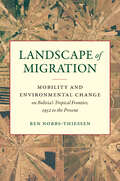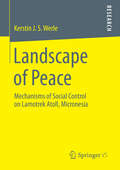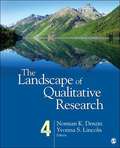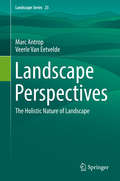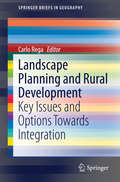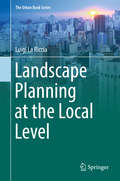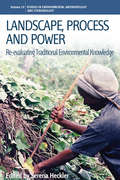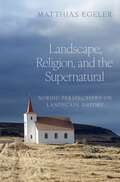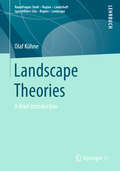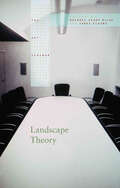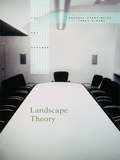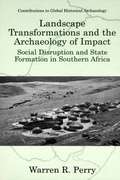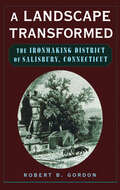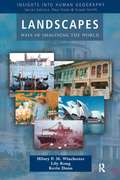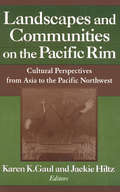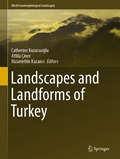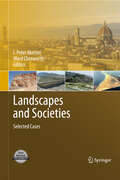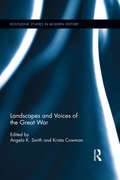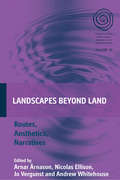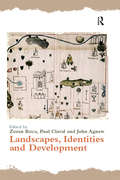- Table View
- List View
Landscape of Migration: Mobility and Environmental Change on Bolivia's Tropical Frontier, 1952 to the Present (Flows, Migrations, and Exchanges)
by Ben Nobbs-ThiessenIn the wake of a 1952 revolution, leaders of Bolivia's National Revolutionary Movement (MNR) embarked on a program of internal colonization known as the "March to the East." In an impoverished country dependent on highland mining, the MNR sought to convert the nation's vast "undeveloped" Amazonian frontier into farmland, hoping to achieve food security, territorial integrity, and demographic balance. To do so, they encouraged hundreds of thousands of Indigenous Bolivians to relocate from the "overcrowded" Andes to the tropical lowlands, but also welcomed surprising transnational migrant streams, including horse-and-buggy Mennonites from Mexico and displaced Okinawans from across the Pacific.Ben Nobbs-Thiessen details the multifaceted results of these migrations on the environment of the South American interior. As he reveals, one of the "migrants" with the greatest impact was the soybean, which Bolivia embraced as a profitable cash crop while eschewing earlier goals of food security, creating a new model for extractive export agriculture. Half a century of colonization would transform the small regional capital of Santa Cruz de la Sierra into Bolivia's largest city, and the diverging stories of Andean, Mennonite, and Okinawan migrants complicate our understandings of tradition, modernity, foreignness, and belonging in the heart of a rising agro-industrial empire.
Landscape of Peace: Mechanisms of Social Control on Lamotrek Atoll, Micronesia
by Kerstin J. WerleKerstin Werle’s work is based upon a year of fieldwork on Lamotrek and Yap, belonging to a group of islands with a matrilineal culture. Although a trend to the lifestyle of the Western world can be found everywhere on the islands, traditional customs, a gendered division of labour and subsistence techniques prevail. Kerstin Werle carried out her research according to classical anthropological methods, supplementing the available specialist literature on the widespread Micronesian atolls with a valuable overview. Her book shows how the ideal of an old and wise woman, contained in the cultural symbol lavalava, is faced with a young society. Due to the extremely limited space on the small atolls, individual plots of land have become historically, culturally and emotionally significant places, all of which have been ascribed their own individual character. With the help of these personalized places, people on Lamotrek pursue local politics.
The Landscape of Qualitative Research (4th Edition) (PDF)
by Norman Denzin Yvonna LincolnThe Landscape of Qualitative Research, Fourth Edition is Volume I of the three-volume paperback editions of The SAGE Handbook of Qualitative Research, Fourth Edition. This contents include full chapters from "Part I: Locating the Field," "Part II: Paradigms and Perspectives in Contention," and "Part VI: the Future of Qualitative Research" from the complete handbook. The Landscape of Qualitative Research, Fourth Edition aims to put the field of qualitative research in context. It offers background on the field, starting with history, then action research and the academy, and the politics and ethics of qualitative research. It then isolates what we regard as the major historical and contemporary paradigms now structuring and influencing qualitative research in the human disciplines. The chapters move from competing paradigms (positivist, postpositivist, constructivist, critical theory) to specific interpretive perspectives, feminisms, racialized discourses, cultural studies, sexualities, and queer theory. It concludes with consideration for the future of qualitative research.
Landscape Perspectives: The Holistic Nature of Landscape (Landscape Series #23)
by Marc Antrop Veerle Van EetveldeClimb a mountain and experience the landscape. Try to grasp its holistic nature. Do not climb alone, but with others and share your experience. Be sure the ways of seeing the landscape will be very different. We experience the landscape with all senses as a complex, dynamic and hierarchically structured whole. The landscape is tangible out there and simultaneously a mental reality. Several perspectives are obvious because of language, culture and background. Many disciplines developed to study the landscape focussing on specific interest groups and applications. Gradually the holistic way of seeing became lost. This book explores the different perspectives on the landscape in relation to its holistic nature. We start from its multiple linguistic meanings and a comprehensive overview of the development of landscape research from its geographical origins to the wide variety of today’s specialised disciplines and interest groups. Understanding the different perspectives on the landscapes and bringing them together is essential in transdisciplinary approaches where the landscape is the integrating concept.
Landscape Planning and Rural Development: Key Issues and Options Towards Integration (SpringerBriefs in Geography)
by Carlo RegaThis book aims to contribute to the current debate on how to integrate rural development policies and landscape planning in rural areas. It highlights the key issues at stake and the possibilities for synergies between landscape planning and policies in light of European development policies, particularly the EU’s Rural Development Policy and the Common Agricultural Policy (CAP). Case studies from different rural contexts and landscapes are provided, illustrating tools and options to make the advocated integration operational. Recommendations and guidance to policy making are proposed. The case studies presented cover 1) the use of visual assessment techniques to support landscape planning in rural areas; 2) participative applications of landscape assessment techniques in peri-urban areas; 3) multi-scale approaches to landscape management in Alpine areas and 4) the application of landscape economic evaluation to foster rural development strategies.
Landscape Planning at the Local Level (The Urban Book Series)
by Luigi La RicciaThe book, showing virtuous examples of urban planning in Italy and Europe, exposes certain doubts and open questions: what is the new role of urban planning? What actions / rules are now achievable for the protection, planning and management of local-scale landscapes? The overall reflections gathered in the book contribute to suggest innovative visions about landscape planning at local scale, seen as first steps towards a more functional change of perspective. New landscapes are the result of local planning practices that no longer seem able to “understand” the current society through urban design. Public space and new urban centralities interact with the increasingly complex functions of social life and mark the distance from territorial values, relying less and less on physical relationships (economic and functional) and increasingly on symbolic and intangible relationships, as ‘cultural identity’. Landscape is essential for the sustainable future of the urban and rural territory: the landscape quality is a factor of economic competitiveness and acts also as a factor of social cohesion and integration.
Landscape, Process and Power: Re-evaluating Traditional Environmental Knowledge (Environmental Anthropology and Ethnobiology #10)
by Serena HecklerIn recent years, the field of study variously called local, indigenous or traditional environmental knowledge (TEK) has experienced a crisis brought about by the questioning of some of its basic assumptions. This has included reassessing notions that scientific methods can accurately elicit and describe TEK or that incorporating it into development projects will improve the physical, social or economic well-being of marginalized peoples. The contributors to this volume argue that to accurately and appropriately describe TEK, the historical and political forces that have shaped it, as well as people’s day-to-day engagement with the landscape around them must be taken into account. TEK thus emerges, not as an easily translatable tool for development experts, but as a rich and complex element of contemporary lives that should be defined and managed by indigenous and local peoples themselves.
Landscape, Religion, and the Supernatural: Nordic Perspectives on Landscape Theory (AAR Religion, Culture, and History)
by Matthias EgelerThis is an open access title available under the terms of a CC BY-NC-ND 4.0 International licence. It is free to read on Oxford Academic and offered as a free PDF download from OUP and selected open access locations. All societies fill the geographical space in which they are living with the holy, the sacred, and the supernatural. A lively academic debate has developed in the last few decades about how human beings make the landscapes that they live in and how these landscapes work. This discussion has repeatedly referenced religion and the supernatural, but it has never engaged either in significant depth. Landscape, Religion, and the Supernatural: Nordic Perspectives on Landscape Theory presents a summa of current and classic theorizing on religion and the supernatural in relationship to the land and develops these theories further by bringing them into dialogue with a rich set of folkloristic and historical data. Focusing on many different themes, including time and memory, repeating patterns, identity formation, power and subversion, sound, home and unhomeliness, and nature and environment, author Matthias Egeler engages with a broad range of theoretical concepts and approaches from the interdisciplinary fields of landscape theory and the study of religions. He brings this theorizing into dialogue with the rich culture of local storytelling and landscape-related traditional beliefs of the Strandir district of the Icelandic Westfjords. In this rural region, landscape-related traditions have been documented since the early nineteenth century and continue to be important to this day. Confronting this vibrant heritage with the insights of landscape theory--both in and beyond the study of religions--allows important new contributions to both fields, especially through the inclusion of perspectives held by rural populations rather than the urban upper classes that have been the focus of research to date. The example of the Icelandic Westfjords shows the extreme richness of religious and supernatural approaches to the landscape that can be developed in rural communities and how they are significantly and characteristically different from the perspectives found in literature and the arts.
Landscape, Religion, and the Supernatural: Nordic Perspectives on Landscape Theory (AAR Religion, Culture, and History)
by Matthias EgelerThis is an open access title available under the terms of a CC BY-NC-ND 4.0 International licence. It is free to read on Oxford Academic and offered as a free PDF download from OUP and selected open access locations. All societies fill the geographical space in which they are living with the holy, the sacred, and the supernatural. A lively academic debate has developed in the last few decades about how human beings make the landscapes that they live in and how these landscapes work. This discussion has repeatedly referenced religion and the supernatural, but it has never engaged either in significant depth. Landscape, Religion, and the Supernatural: Nordic Perspectives on Landscape Theory presents a summa of current and classic theorizing on religion and the supernatural in relationship to the land and develops these theories further by bringing them into dialogue with a rich set of folkloristic and historical data. Focusing on many different themes, including time and memory, repeating patterns, identity formation, power and subversion, sound, home and unhomeliness, and nature and environment, author Matthias Egeler engages with a broad range of theoretical concepts and approaches from the interdisciplinary fields of landscape theory and the study of religions. He brings this theorizing into dialogue with the rich culture of local storytelling and landscape-related traditional beliefs of the Strandir district of the Icelandic Westfjords. In this rural region, landscape-related traditions have been documented since the early nineteenth century and continue to be important to this day. Confronting this vibrant heritage with the insights of landscape theory--both in and beyond the study of religions--allows important new contributions to both fields, especially through the inclusion of perspectives held by rural populations rather than the urban upper classes that have been the focus of research to date. The example of the Icelandic Westfjords shows the extreme richness of religious and supernatural approaches to the landscape that can be developed in rural communities and how they are significantly and characteristically different from the perspectives found in literature and the arts.
Landscape Theories: A Brief Introduction (RaumFragen: Stadt – Region – Landschaft)
by Olaf KühneIn the past decades, the discussion about theoretical approaches to the topic of 'landscape' has increased. This book presents the currently discussed theoretical approaches to landscape and shows its potentials and limits. The theoretical approaches are discussed on the basis of current questions, such as socialisation and the hybridisation of landscape, and combined with empirical results. This is followed by a discussion of the landscape policy operationalisation of theoretical considerations and empirical findings.
Landscape Theory (The Art Seminar)
by Rachael Ziady DeLUE James ElkinsArtistic representations of landscape are studied widely in areas ranging from art history to geography to sociology, yet there has been little consensus about how to understand the relationship between landscape and art. This book brings together more than fifty scholars from these multiple disciplines to establish new ways of thinking about landscape in art.
Landscape Theory (The Art Seminar)
by Rachel DeLue James ElkinsArtistic representations of landscape are studied widely in areas ranging from art history to geography to sociology, yet there has been little consensus about how to understand the relationship between landscape and art. This book brings together more than fifty scholars from these multiple disciplines to establish new ways of thinking about landscape in art.
Landscape Transformations and the Archaeology of Impact: Social Disruption and State Formation in Southern Africa (Contributions To Global Historical Archaeology)
by Warren R. PerryAn attempt to use archaeological materials to investigate the colonization of southeastern Africa during the period 1500 to 1900. Perry demonstrates the usefulness of archaeology in bypassing the biases of the ethnohistorical and documentary record and generating a more comprehensive understanding of history. Special attention is paid to the period of state formation in Swaziland and a critique of the `Settler Model', which the author finds to be invalid.
A Landscape Transformed: The Ironmaking District of Salisbury, Connecticut
by Robert B. GordonThis book examines the industrial ecology of 200 years of ironmaking with renewal energy resources in northwestern Connecticut. It focuses on the cultural context of people's decisions about technology and the environment, and the gradual transition they effected in their land from industrial landscape to pastoral countryside.
Landscapes: Ways of Imagining the World
by Hilary P.M. WinchesterFirst published in 2003. Routledge is an imprint of Taylor & Francis, an informa company.
Landscapes: Ways of Imagining the World
by Hilary P.M. WinchesterFirst published in 2003. Routledge is an imprint of Taylor & Francis, an informa company.
Landscapes and Communities on the Pacific Rim: From Asia to the Pacific Northwest
by Karen K. Gaul Jackie HiltzThese essays offer a cross-cultural and cross-disciplinary study of the ways in which communities of people understand and inhabit their environments. They examine and compare human/environmental interactions in communities across the Pacific Northwest, the Pacific Rim, and Asia.
Landscapes and Communities on the Pacific Rim: From Asia to the Pacific Northwest (A\study Of The Maureen And Mike Mansfield Center Ser.)
by Karen K. Gaul Jackie HiltzThese essays offer a cross-cultural and cross-disciplinary study of the ways in which communities of people understand and inhabit their environments. They examine and compare human/environmental interactions in communities across the Pacific Northwest, the Pacific Rim, and Asia.
Landscapes and Landforms of Turkey (World Geomorphological Landscapes)
by Catherine Kuzucuoğlu Attila Çiner Nizamettin KazancıThis book on Turkish geomorphology offers location descriptions, based on their dynamics and evolution processes, including hydrology, tectonics, volcanism, slopes, coasts, ice/snow, and wind. It presents landforms as a result of evolution (Quaternary, Holocene, historic) and in relation to the elements determining and/or impacting this evolution (vegetation, soil, hydrology, geology, climate, sea level and human action) as well as the resulting landscapes. Richly illustrated with pictures from each site, including geomorphological maps and sections, it explains the risks associated with the geomorphological dynamics (on local and global scales), natural and/or cultural heritage (archaeology, prehistory, history, architectural specifications adapted to the landscape), as well as challenges for human society (endangered landscape, protection/conservation rules/statutes, posters/paintings.).
Landscapes and Societies: Selected Cases
by I. Peter Martini and Ward ChesworthThis book contains case histories intended to show how societies and landscapes interact. The range of interest stretches from the small groups of the earliest Neolithic, through Bronze and Iron Age civilizations, to modern nation states. The coexistence is, of its very nature reciprocal, resulting in changes in both society and landscape. In some instances the adaptations may be judged successful in terms of human needs, but failure is common and even the successful cases are ephemeral when judged in the light of history.Comparisons and contrasts between the various cases can be made at various scales from global through inter-regional, to regional and smaller scales. At the global scale, all societies deal with major problems of climate change, sea-level rise, and with ubiquitous problems such as soil erosion and landscape degradation. Inter-regional differences bring out significant detail with one region suffering from drought when another suffers from widespread flooding. For example, desertification in North Africa and the Near East contrasts with the temperate countries of southern Europe where the landscape-effects of deforestation are more obvious. And China and Japan offer an interesting comparison from the standpoint of geological hazards to society - large, unpredictable and massively erosive rivers in the former case, volcanoes and accompanying earthquakes in the latter. Within the North African region localized climatic changes led to abandonment of some desertified areas with successful adjustments in others, with the ultimate evolution into the formative civilization of Egypt, the "Gift of the Nile". At a smaller scale it is instructive to compare the city-states of the Medieval and early Renaissance times that developed in the watershed of a single river, the Arno in Tuscany, and how Pisa, Siena and Florence developed and reached their golden periods at different times depending on their location with regard to proximity to the sea, to the main trunk of the river, or in the adjacent hills.Also noteworthy is the role of technology in opening up opportunities for a society. Consider the Netherlands and how its history has been formed by the technical problem of a populous society dealing with too much water, as an inexorably rising sea threatens their landscape; or the case of communities in Colorado trying to deal with too little water for farmers and domestic users, by bringing their supply over a mountain chain. These and others cases included in the book, provide evidence of the successes, near misses and outright failures that mark our ongoing relationship with landscape throughout the history of Homo sapiens. The hope is that compilations such as this will lead to a better understanding of the issue and provide us with knowledge valuable in planning a sustainable modus vivendi between humanity and landscape for as long as possible.Audience: The book will interest geomorphologists, geologists, geographers, archaeologists, anthropologists, ecologists, environmentalists, historians and others in the academic world. Practically, planners and managers interested in landscape/environmental conditions will find interest in these pages, and more generally the increasingly large body of opinion in the general public, with concerns about Planet Earth, will find much to inform their opinions.Extra material: The color plate section is available at http://extras.springer.com
Landscapes and Voices of the Great War (Routledge Studies in Modern History #22)
by Angela K. Smith Krista CowmanThis volume aims to provide a wider view of First World War experience through focusing on landscapes less commonly considered in historiography, and on voices that have remained on the margins of popular understanding of the war. The landscape of the western front was captured during the conflict in many different ways: in photographs, paintings and print. The most commonly replicated voicing of contemporary attitudes towards the war is that of initial enthusiasm giving way to disillusionment and a sense of overwhelming futility. Investigations of the many components of war experience drawn from social and cultural history have looked to landscapes and voices beyond the frontline as a means of foregrounding different perspectives on the war. Not all of the voices presented here opposed the war, and not all of the landscapes were comprised of trenches or flanked by barbed wire. Collectively, they combine to offer further fresh insights into the multiplicity of war experience, an alternate space to the familiar tropes of mud and mayhem.
Landscapes and Voices of the Great War (Routledge Studies in Modern History #22)
by Angela K. Smith Krista CowmanThis volume aims to provide a wider view of First World War experience through focusing on landscapes less commonly considered in historiography, and on voices that have remained on the margins of popular understanding of the war. The landscape of the western front was captured during the conflict in many different ways: in photographs, paintings and print. The most commonly replicated voicing of contemporary attitudes towards the war is that of initial enthusiasm giving way to disillusionment and a sense of overwhelming futility. Investigations of the many components of war experience drawn from social and cultural history have looked to landscapes and voices beyond the frontline as a means of foregrounding different perspectives on the war. Not all of the voices presented here opposed the war, and not all of the landscapes were comprised of trenches or flanked by barbed wire. Collectively, they combine to offer further fresh insights into the multiplicity of war experience, an alternate space to the familiar tropes of mud and mayhem.
Landscapes Beyond Land: Routes, Aesthetics, Narratives (EASA Series #19)
by Arnar Árnason Nicolas Ellison Jo Vergunst Andrew WhitehouseLand is embedded in a multitude of material and cultural contexts, through which the human experience of landscape emerges. Ethnographers, with their participative methodologies, long-term co-residence, and concern with the quotidian aspects of the places where they work, are well positioned to describe landscapes in this fullest of senses. The contributors explore how landscapes become known primarily through movement and journeying rather than stasis. Working across four continents, they explain how landscapes are constituted and recollected in the stories people tell of their journeys through them, and how, in turn, these stories are embedded in landscaped forms.
Landscapes, Identities and Development
by Zoran Roca Paul Claval John AgnewBringing together theoretical and empirical research from 22 countries in Europe, North America, Australia, South America and Japan, this book offers a state-of-the-art survey of conceptual and methodological research and planning issues relating to landscape, heritage, [and] development. It has 30 chapters grouped in four main thematic sections: landscapes as a constitutive dimension of territorial identities; landscape history and landscape heritage; landscapes as development assets and resources; and landscape research and development planning. The contributors are scholars from a wide range of cultural and professional backgrounds, experienced in fundamental and applied research, planning and policy design. They were invited by the co-editors to write chapters for this book on the basis of the theoretical frameworks, case-study research findings and related policy concerns they presented at the 23rd Session of PECSRL - The Permanent European Conference for the Study of the Rural Landscape, organized by TERCUD - Territory, Culture and Development Research Centre, Universidade Lusófona, in Lisbon and Óbidos, Portugal, 1 - 5 September 2008. With such broad inter-disciplinary relevance and international scope, this book provides a valuable overview, highlighting recent findings and interpretations on historical, current and prospective linkages between changing landscapes and natural, economic, cultural and other identity features of places and regions; landscape-related identities as local and regional development assets and resources in the era of globalized economy and culture; the role of landscape history and heritage as platforms of landscape research and management in European contexts, including the implementation of The European Landscape Convention; and, the strengthening of the landscape perspective as a constitutive element of sustainable development.
Landscapes, Identities and Development
by ZORAN ROCA, PAUL CLAVAL AND JOHN AGNEWBringing together theoretical and empirical research from 22 countries in Europe, North America, Australia, South America and Japan, this book offers a state-of-the-art survey of conceptual and methodological research and planning issues relating to landscape, heritage, [and] development. It has 30 chapters grouped in four main thematic sections: landscapes as a constitutive dimension of territorial identities; landscape history and landscape heritage; landscapes as development assets and resources; and landscape research and development planning. The contributors are scholars from a wide range of cultural and professional backgrounds, experienced in fundamental and applied research, planning and policy design. They were invited by the co-editors to write chapters for this book on the basis of the theoretical frameworks, case-study research findings and related policy concerns they presented at the 23rd Session of PECSRL - The Permanent European Conference for the Study of the Rural Landscape, organized by TERCUD - Territory, Culture and Development Research Centre, Universidade Lusófona, in Lisbon and Óbidos, Portugal, 1 - 5 September 2008. With such broad inter-disciplinary relevance and international scope, this book provides a valuable overview, highlighting recent findings and interpretations on historical, current and prospective linkages between changing landscapes and natural, economic, cultural and other identity features of places and regions; landscape-related identities as local and regional development assets and resources in the era of globalized economy and culture; the role of landscape history and heritage as platforms of landscape research and management in European contexts, including the implementation of The European Landscape Convention; and, the strengthening of the landscape perspective as a constitutive element of sustainable development.
